“Birds do it, bees do it…
People say in Boston even beans do it.
Let’s do it, let’s fall in love.”
Cole Porter, Birds Do It, Bees Do It
We at Finca Luna Nueva agree with those Bostonians: beans do it! Vanilla beans, that is. Abundant vanilla vines produce large displays of orchid flowers, and if evolution has emotions this is all in hope that the right bees will come calling, collect fragrant volatile vanilla oils, and in the process fertilize the awaiting ovules. If all goes right, bring on the beans!
. 
But here’s the tough news for the vanilla orchids: while our shiny and energetic emerald orchid bees “do it,” they really don’t do it well, at least not well enough to facilitate commercial production of vanilla beans.
So what are we humans supposed to do? People in Mesoamerica have been in love with the vanilla flavor for thousands of years. Europeans came late but strong to the vanilla love affair, “discovering” the vanilla flavor in 1520 when an Aztec king courteously served the “Drink of the Gods” a/k/a spicy hot chocolate to Spanish conquistador Hernán Cortés. Cortés demanded that the king reveal the recipe for the Drink of the Gods (must have been quite the conversation!), and he learned that the secret sauce included vanilla along with other spices that we grow here at our farm. Cortés pirated this information back to Spain, and thus was launched the European hunger for cacao and vanilla. Chocolate? Vanilla ice cream? Baked goods? Yes to all, we shouted! Give us more and more vanilla, notwithstanding the “inefficiency” of natural pollination.
Back to the bees. If Earth Day (today!) and Valentine’s Day met and had a love child, it would be these diminutive, emerald-green, and mostly hairless beauties. The vanilla orchids need to be pollinated, and unlike many flowers that tempt pollinators with pollen and nectar, these orchids attract male Euglossine bees with volatile oils. Male orchid bees are flying Emperors of Scent in the rainforest: here’s how Stephen Buchmann of Pollinator Partnership describes their perfume magic:
Male euglossines visit orchids in addition to tree wounds, fungi and certain flowers to collect scent volatiles. Using specialized scraper hairs on their front legs, they gather up these essential oils and store them within glands in their inflated hind legs. Over a period of weeks or months, males collect a species-specific mixture of scents. One or more males gather in “leks” display sites on tree trunks where they release some of their harvested scents while buzzing, flying out from their tree, and returning. Although rarely observed, females seem to choose among males and mate with them in these territorial sites.
It’s a desperate high-school dance night on that lek, redolent of designer perfumes and abuzz with hope. We can report that some of those elusive females must be swooning, as the orchid bee population gets regularly replenished and some modest degree of vanilla orchid pollination happens year after year. We rarely see the bees at work, but we can judge this by the vanilla fruits: about one orchid out of a thousand will turn into a vanilla bean. With each bean containing tens of thousands of seeds, that natural process keeps the vanilla species in the evolutionary game. What that won’t do, however, is give humans enough vanilla for making chocolate, vanilla cream, or other foods. We humans needed some way to augment natural pollination, and a twelve-year old child enslaved in a former French island colony is thought to have invented hand pollination in 1841.
Scroll forward 177 years and accompany us to the hand pollination occuring this month at Finca Luna Nueva. Photos taken over a two-day period illustrate the delicacy of this delicacy. Carlos Arias is our guide, and for those new to our farm Carlos was the very first local farmer brought on board when our founder Steven Farrell created Finca Luna Nueva. Carlos has been with us for almost 25 years, his father don Porfirio of blessed memory was the driver of our team of oxen, while his brother Walter is a master of many aspects of our farm’s operations. Carlos is pictured below, with the insert showing the orchids ready for pollination.
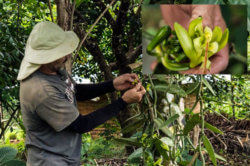
We have vanilla vines growing throughout the farm, but the area of greatest concentration is near our Rainforest Mysteries Trail. When you see the somewhat groomed area around the vanilla vines, please imagine this immediately adjacent scene of Monkey Ladder, Bauhinia glabra, seen here through the morning mist:
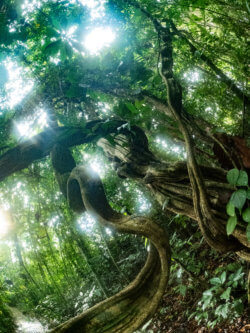
A small group of us apprenticed to Carlos over the two-day period. He was particularly focused on training Steven (old dog, new tricks?), who’s had mixed results over the years in the pollination process. Carlos also demonstrated the process to our dear friend Steven Hoffman and to Terry and me.
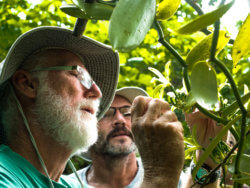
Carlos demonstrating pollination to Steven
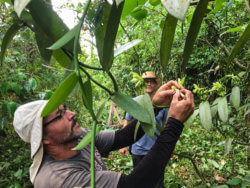
Steven Hoffman watching the master at work
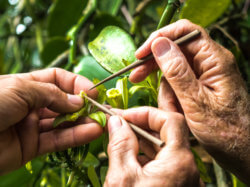
Using the bamboo/thumb technique invented by Albius
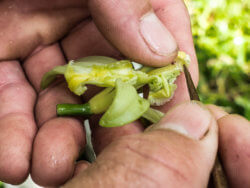
You have to gently lift a flap of tissue to expose the pollen


Carlos even tried teaching me how to do it. He marked the flower and we’ll soon know if the pollination was successful
We invite everyone to visit our farm and check in on the progress of our vanilla pollination. We offer daily farm tours, where we teach the basics of regenerative and biodynamic agriculture. We also offer a cacao experience/chocolate tour, where we take our guests on a thousand-year journey through the history of cacao. Remember Cortés demanding the secret recipe for the Drink of the Gods? Maybe it’s time you tasted the beverage that launched the world cacao and vanilla trade.

Pura Vida, and Happy Earth Day!

